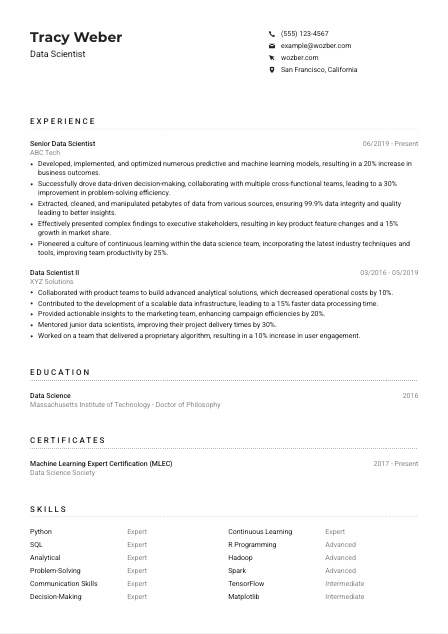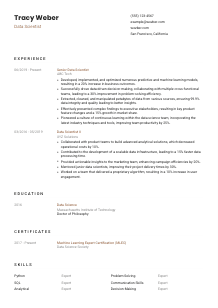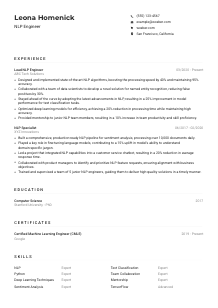Data Scientist Resume Example
Delving deep into data, but your resume doesn't compute? Explore this Data Scientist resume example, algorithmically assembled with Wozber free resume builder. See how fluidly you can present your statistical sorcery to match job models, ensuring your career trajectory is exponential, not asymptotic!

How to write a Data Scientist Resume?
Greetings, aspiring Data Scientist! In the realm of numbers, algorithms, and predictive models, your resume is your personal algorithm that leads to career success. Crafting a resume that not only highlights your expertise but also speaks directly to the job you're eyeing is crucial in the data-driven job market.
With the aid of Wozber's free resume builder, this guide will navigate through the intricacies of tailoring your Data Scientist resume, ensuring it's a perfect match for your dream role. Let's transform your resume into a compelling narrative that places you at the forefront of the candidate pool!
Personal Details
The Personal Details section is your initial handshake with potential employers. This is where you make your first impression resonate. Let's dive into how to optimize this section for a Data Scientist role, ensuring it's not just accurate, but also a beacon to hiring managers.
1. Brand Yourself with Your Name
Your name isn't just an identifier; it's your personal brand. Highlight it with a clear, professional font, making it slightly larger than the rest of your resume text. It's the first step in ensuring you stand out.
2. Position Yourself with Precision
Directly below your name, align yourself with the role by precisely stating 'Data Scientist'. This immediately aligns your personal brand with the job, making it clear to hiring managers what you're after.
3. Make Contact Details Count
Provide your most reliable contact number and a professional email address, preferably in the 'firstname.lastname@email.com' format. These small details ensure you're ready for professional communication.
4. Location Is Key
Given that the job specifies 'Must be located in San Francisco, California,' including this detail in your contact information ticks a crucial box, showing you're in the right locale or willing to relocate.
5. Digital Footprint
If applicable, add a link to your professional online presence, such as a LinkedIn profile or a personal website showcasing your portfolio. Ensure these profiles mirror your resume's professionalism.
Takeaway
The Personal Details section isn't just about contact info; it's about establishing a professional persona right from the start. Ensure it's perfectly aligned with the Data Scientist role you're targeting. Consider it the foundation on which your resume narrative is built.





Experience
The Experience section is where your resume truly begins to differentiate. It's your chance to showcase how your past roles have prepared you for the Data Scientist position.
- Developed, implemented, and optimized numerous predictive and machine learning models, resulting in a 20% increase in business outcomes.
- Successfully drove data‑driven decision‑making, collaborating with multiple cross‑functional teams, leading to a 30% improvement in problem‑solving efficiency.
- Extracted, cleaned, and manipulated petabytes of data from various sources, ensuring 99.9% data integrity and quality leading to better insights.
- Effectively presented complex findings to executive stakeholders, resulting in key product feature changes and a 15% growth in market share.
- Pioneered a culture of continuous learning within the data science team, incorporating the latest industry techniques and tools, improving team productivity by 25%.
- Collaborated with product teams to build advanced analytical solutions, which decreased operational costs by 10%.
- Contributed to the development of a scalable data infrastructure, leading to a 15% faster data processing time.
- Provided actionable insights to the marketing team, enhancing campaign efficiencies by 20%.
- Mentored junior data scientists, improving their project delivery times by 30%.
- Worked on a team that delivered a proprietary algorithm, resulting in a 10% increase in user engagement.
1. Begin with the Job Description
Thoroughly analyze the job description provided. Extract keywords and phrases related to responsibilities and qualifications that you can mirror in your accomplishments. This is the first step towards ATS optimization.
2. Present Your Journey
List your roles in reverse chronological order, starting with the most recent. Be sure to include the job title, company name, and your tenure there. This structured approach helps hiring managers quickly understand your career trajectory.
3. Achievements That Resonate
For every listed role, articulate how you contributed to business outcomes. Tailor these achievements to reflect the job's requirements, such as 'Developed, implemented, and optimized numerous predictive and machine learning models, resulting in a 20% increase in business outcomes.'
4. Quantify Your Impact
Whenever possible, bolster your accomplishments with numbers. Saying you 'extracted, cleaned, and manipulated petabytes of data' adds weight to your claims and provides tangible evidence of your capabilities.
5. Relevance Over Volume
It might be tempting to list all your past responsibilities, but focus on the most relevant experiences. Link them directly to the job description, ensuring your resume is a well-crafted narrative of your qualifications for the Data Scientist role.
Takeaway
Your Experience section is a testament to your journey and capabilities. Ensure it speaks directly to what hiring managers are looking for in a Data Scientist. Tailoring your experiences to the job requirements makes your resume not just a document, but a compelling story of your professional journey.
Education
Your Education section should shine a spotlight on your background in the quantitative fields that underpin the Data Scientist role. This is where you assure hiring managers of your foundational knowledge.
1. Match the Job's Educational Demands
Identify the specific educational qualifications the job description emphasizes, such as a 'Master's or Ph.D. in a quantitative field.' Listing your 'Doctor of Philosophy in Data Science' fulfills this requirement precisely.
2. A Clear Structure
Maintain a simple, yet impactful format. List your highest degree first, followed by any others relevant to the role. Be sure to include the degree title, institution name, and date of completion.
3. Degree Details
If the job description specifies a particular field of study, make sure your degree aligns with this requirement. Highlighting your 'Master of Science in Applied Statistics,' for instance, directly connects to the desired qualifications.
4. Courses and Projects
For early-career professionals, listing relevant coursework or projects can be beneficial. However, for a senior role like this Data Scientist position, focusing on degrees and certifications is more pertinent.
5. Academic Excellence
Should you have any academic achievements that further establish your qualification for the role, briefly mention them. Distinctions in quantitative courses, for example, are worth noting but keep the emphasis on your degrees.
Takeaway
Craft your Education section to reflect the robust academic background required for a Data Scientist. Your educational history is not just a list of degrees; it's proof of your dedication and readiness for the challenges of the role.
Certificates
Certificates are your opportunity to show continuous learning and specialization. For a Data Scientist, certain certifications can set you apart from the competition.
1. Focus on Relevant Certifications
Though the job description doesn't list specific certificate requirements, selecting ones that enhance your qualifications for a Data Scientist role is key. For example, 'Machine Learning Expert Certification (MLEC)' showcases specialized knowledge crucial to the job.
2. Choose Quality Over Quantity
Prioritize listing certifications that directly relate to the role's responsibilities and requirements. This ensures that hiring managers see the most relevant information without needing to sift through a long list of credentials.
3. Transparency with Dates
If a certification is recently attained or has an expiration date, including this information can showcase your commitment to staying current in your field. It highlights your initiative in continuous improvement and learning.
4. Pursue Ongoing Learning
Data science is an evolving field. Demonstrating that you're engaging with new technologies and methodologies through current certifications or courses proves your adaptability and eagerness to grow.
Takeaway
Your certifications are a testament to your commitment to professional development. For Data Scientist roles, they can significantly bolster your credentials, providing clear indicators of your knowledge and specialties. Remember, in data science, staying ahead of the curve is paramount.
Skills
The Skills section offers a concise overview of your professional toolkit. Here's how to curate a Skills list that aligns with both the demands of a Data Scientist role and the expectations of hiring managers.
1. Decipher the Job Post
Identify both the stated and implied skills within the job description. Skills like 'Python,' 'SQL,' and 'Analytical Thinking' are explicitly mentioned and should definitely feature on your resume.
2. Highlight Pertinent Skills
Your list should directly reflect the skills mentioned in the job posting. This not only assures ATS compliance but also showcases your candidacy as aligning perfectly with the role's demands.
3. Organization Matters
While including every skill you possess can be tempting, focusing on the most relevant ones positions you as a strong candidate. Your skillset should be a refined list that catches the hiring manager's eye immediately.
Takeaway
Your skills section is a lens through which hiring managers assess your fit for the Data Scientist role. Tailor it to reflect the job's needs, creating a clear picture of how your expertise aligns with the role's demands. It's not just about having the right tools; it's about showcasing them effectively.
Languages
In a globalized industry, language skills can greatly enhance your appeal as a candidate. Here's how to effectively present your linguistic capabilities in alignment with the requirements of a Data Scientist position.
1. Examine Language Requirements
For this role, 'English proficiency' is expressly required. Ensure this is evident in your resume, prioritizing it in your languages list, and indicate your proficiency level as 'Native' or 'Fluent.'
2. Prioritize Important Languages
If the job description mentions specific language skills, list them prominently. For other roles, consider the company's global reach and any additional languages that could be an asset.
3. Mention Additional Languages
Beyond the specified requirements, noting other languages you're proficient in can broaden your appeal, especially in roles requiring international collaboration. It's a testament to your potential versatility and adaptability.
4. Honesty in Proficiency
Be clear about your level of fluency in each language. This honesty ensures realistic expectations and demonstrates integrity.
5. Role and Language Synergy
For roles with a strong international component, your language skills can significantly boost your employability. Even if not directly required, they underscore your ability to navigate a global workplace.
Takeaway
Your ability to communicate in multiple languages is more than a linguistic achievement; it's a professional asset that can differentiate you in the job market. Highlighting your language skills can place you a step ahead, especially in roles where communication and diversity are valued.
Summary
The Summary is your opportunity to encapsulate your professional identity. It sets the tone for your resume, highlighting why you're the ideal candidate for a Data Scientist position.
1. Capture the Job Essence
Begin by distilling the core requirements of the job into a clear and compelling overview. This is about showing, at a glance, why you're not just a fit, but the perfect choice for the role.
2. Start with Who You Are
Introduce yourself as a Data Scientist, focusing on your years of experience and specific areas of expertise. This initial statement sets the stage for what follows.
3. Showcase Your Achievements
Highlight your most relevant skills and accomplishments, ensuring they align with the job's needs. Your aim is to succinctly communicate the unique value you bring to the role.
4. Conciseness Is Key
While it's crucial to be comprehensive, remember that the Summary is an appetizer, not the main course. Aim for a stimulating preview that invites the hiring manager to delve deeper into your resume.
Takeaway
Your Summary is essentially your professional pitch. It's your chance to quickly convey your suitability for the Data Scientist role, inviting the hiring manager to explore the details of your career journey. Make it count!
Your Data Scientist Resume: A Launchpad for Success
Congratulations! You're now equipped to craft a Data Scientist resume that not only fulfills but surpasses expectations. Utilize Wozber's free resume builder, leveraging ATS-friendly resume templates and ATS optimization tools, to ensure that your resume not only looks great but also ranks high in Applicant Tracking Systems. Remember, your resume is a dynamic document, a reflection of your ongoing growth and achievements.
Keep it updated, keep tailoring, and let it serve as your beacon in the data science career landscape. The exciting world of data science awaits your contribution. Ready, set, impact!

- Master's or Ph.D. in a quantitative field such as Mathematics, Statistics, Computer Science, or related discipline.
- Minimum of 3 years of professional experience in data science, machine learning, and statistical modeling.
- Proficiency in programming languages such as Python or R, and advanced knowledge in SQL.
- Strong experience with big data tools and ecosystems such as Hadoop, Spark, or related platforms.
- Excellent analytical, problem-solving, and communication skills with the ability to translate complex data into actionable insights.
- English proficiency is a key skill for this position.
- Must be located in San Francisco, California.
- Develop, implement, and optimize predictive and machine learning models that impact business outcomes.
- Drive data-driven decision-making by collaborating with cross-functional teams to identify and solve critical business problems.
- Extract, clean, and manipulate large datasets from multiple sources, ensuring data integrity and quality.
- Present findings and insights to stakeholders, including non-technical audiences, in a clear and compelling manner.
- Stay updated with the latest industry trends, tools, and techniques in data science, promoting a culture of continuous learning within the organization.















